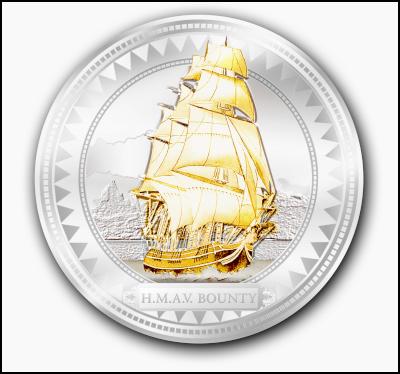Bounty coins are their own reward
Bounty coins are their own reward

Click to enlarge
News release
8 October
2008
Bounty coins are their own reward
Two hundred and nineteen years after the infamous munity onboard the H.M.A.V Bounty, an exclusive set of coins has been produced by the New Zealand Mint to celebrate the dramatic events.
The coins feature an image of the Bounty, one of the world’s most famous ships, and come in a range of gold and silver coins.
“New Zealand Mint is proud to announce the world’s first commemorative coins issued by Pitcairn Island,” says Mark Sutton general manager of the New Zealand Mint.
“The Mutiny on the Bounty has been the subject of at least one novel, three full-length motion pictures, a short movie and a musical. Now those momentous events have been recorded for posterity in a range of superb coins.”
Fletcher Christian and the mutinous members of the Bounty created lasting world-wide notoriety when they cast adrift their captain and loyal crew in the Pacific. Together with their Tahitian wives, concubines and native men, the mutineers went on to establish a fledgling community on Pitcairn Island. Some of their decedents survive there to this day while others moved on to populate Norfolk Island.
“The Bounty story forms one of the most enduring tales of the sea and the New Zealand Mint is proud to commemorate this historical event,” says Mr Sutton.
“The coins make a fantastic gift or keepsake for anyone with an interest in nautical history or the islands of the South Pacific.”
The coins come in 1/4-ounce gold proof (1,500 minted), 1/25-ounce gold proof (10,000 minted), one-ounce silver proof gold guilded (2,000 minted) and one-ounce silver coloured proof like (5,000 minted). The coins are legal tender in the Pitcairn Islands and the obverse of the coins feature Her Majesty Queen Elizabeth II.
Individual coins are displayed in a wooden antique looking chest display case accompanied by Certificate of Authenticity which includes background information on the ship and the mutiny.
Also available are 1,000 special collectors’ sets containing the 1/4-ounce gold and one ounce silver coins. These are presented in a handmade wooden collector’s box, fashioned in the shape of a sea chest, and complete with a working navigator’s sextant.
On the Web: www.newzealandmint.com
ENDS
About New Zealand Mint:
New Zealand Mint
is New Zealand’s only precious metal mint. Founded in
1967, New Zealand Mint has been minting legal tender
commemorative coins, gold bullion and medallions for more
than four decades. Best known for its Gold Kiwi bullion, New
Zealand Mint produces and markets a wide range of precious
metal items including gold and silver bullion coins,
commemorative and collectors coins, as well as
jewellery.
A short history of the
Bounty
Captained by Lieutenant William Bligh, the Bounty set sail from England for Tahiti on 23 December 1787 with a crew of 46 officers and men. After reaching Tahiti on 26 October 1788 the crew set about collecting and growing breadfruit plants for delivery to the West Indies.
For five months the crew lived ashore and became familiar with local customs and culture… and with the beautiful women of Tahiti. During this time the Bounty’s Sailing Master Fletcher Christian married a Tahitian named Maimiti.
The Bounty left Tahiti on 4 April. After a few weeks of punishing treatment and separation from their island companions, 18 crew members led by Christian mutinied and forced Bligh and 18 others into a 23-foot open launch. Bligh managed to navigate them to Timor on an epic 47-day, 3,618 nautical mile voyage equipped only with a sextant and a pocket watch and no charts or compass.
Meanwhile, the mutineers returned to Tahiti to put 16 of the crew ashore. Christian, eight other crewmen, six Tahitian men, and 11 women, one with a baby, then set sail in the Bounty for Pitcairn Island hoping to elude the Royal Navy which had misplaced the island on its maps.
At Pitcairn they took their stores ashore and scuttled the Bounty, burning it in what is now Bounty Bay. To this day her ballast stones are still visible in the water.
Seventeen years later an American sailing ship Topaz reached Pitcairn Island to discover only one mutineer, John Adams, nine women, and some children still surviving.
Five of the mutineers, including Fletcher Christian, had been murdered by Tahitians on Pitcairn Island; one died after a drunken fall; one was killed by the other two survivors after he attacked them; and one died of natural causes. All six of the Tahitian men were killed during the fighting. Of the 11 Tahitian women, two were killed in falls while gathering eggs from a cliff.
Fletcher Christian was survived by Maimiti and their son Thursday October Christian, whose descendants still bear his name. In 1825, John Adams was granted amnesty for his mutiny; Pitcairn’s capital, Adamstown, is named for him.


 Stats NZ: Annual Number Of Home Consents Down 7.4 Percent
Stats NZ: Annual Number Of Home Consents Down 7.4 Percent Plains Media: Plains FM Announces Name Change After 37 Years
Plains Media: Plains FM Announces Name Change After 37 Years NIWA: Flooding From Underneath - New Tool Reveals Shallow Groundwater Elevations
NIWA: Flooding From Underneath - New Tool Reveals Shallow Groundwater Elevations Commerce Commission: Commission Concludes Auckland Airport Over-charging By $190 Million
Commerce Commission: Commission Concludes Auckland Airport Over-charging By $190 Million The Future Is Rail: Ferry Decision - Common Sense Prevails
The Future Is Rail: Ferry Decision - Common Sense Prevails Aotearoa Food Rescue Alliance: Grocery Market Reform Must Include Mandatory Food Rescue Partnerships
Aotearoa Food Rescue Alliance: Grocery Market Reform Must Include Mandatory Food Rescue Partnerships



